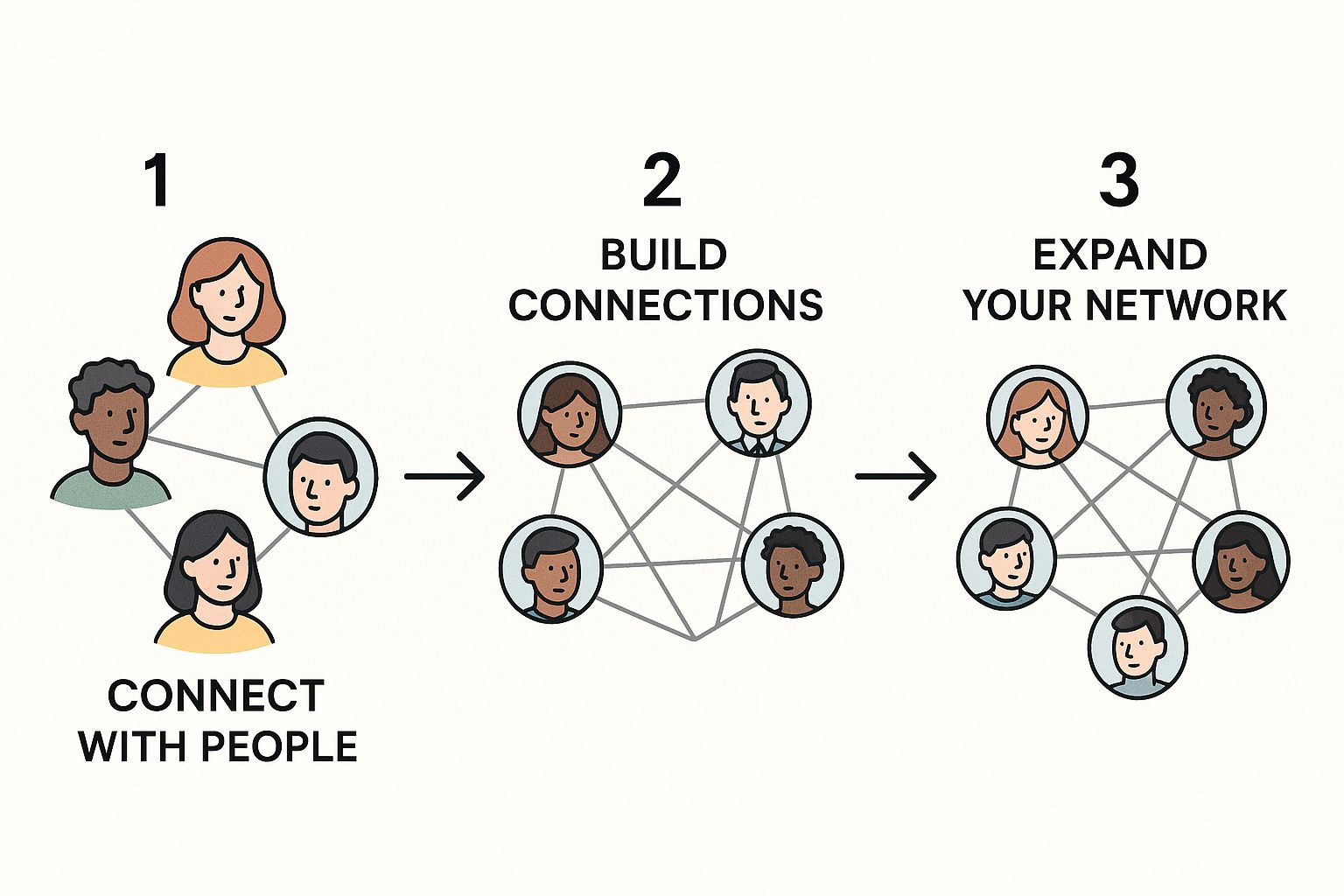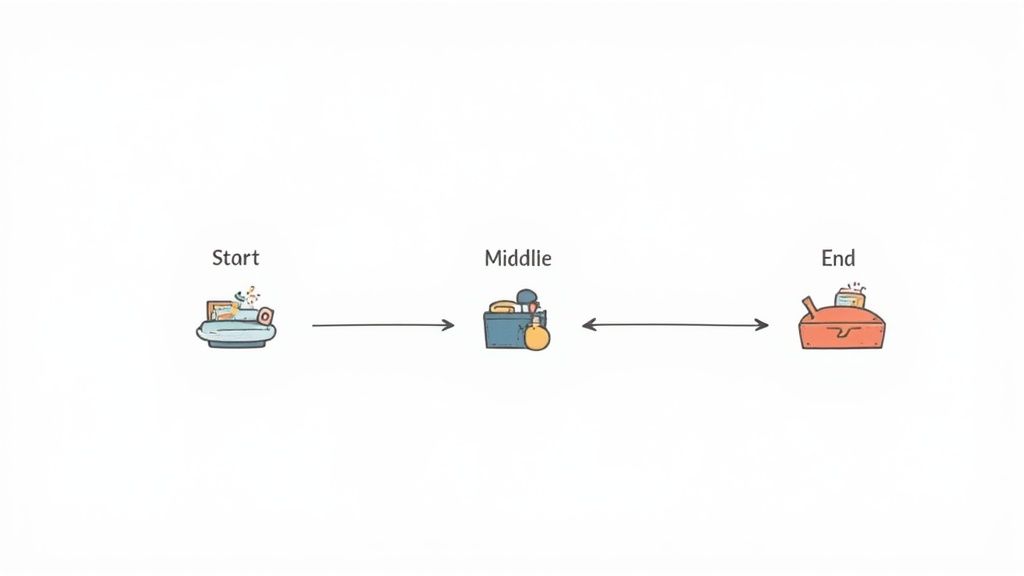When someone on your team is about to leave, whether it’s for a new job or just a two-week vacation, that little out-of-office message just doesn’t cut it. It’s the bare minimum. A proper sample transition plan is what really stands between your team’s smooth sailing and complete and utter chaos.
Think of it as your team’s defense against the classic handover nightmares: missed deadlines, lost knowledge, and confused stakeholders. It’s a simple roadmap that says, “Here’s what’s happening, and here’s who’s taking the wheel.”
Beyond the OOO: Why Your Team Needs a Real Plan
An automated “I’m away” email is a nice heads-up, but let’s be honest, it’s not a strategy. The real work doesn’t just pause when a key person logs off. Without a solid handover process, critical information vanishes into thin air, deadlines get blown, and stakeholder confidence takes a nosedive.
This isn’t just about a few delayed tasks. It’s about the ripple effect of confusion and frustration that can tank team morale and kill productivity. When people are left scrambling to piece together someone else’s job, it creates a ton of unnecessary stress. You end up with a team that’s constantly putting out fires instead of moving forward.
The True Cost of a Bad Handover
Let’s talk about the real-world damage of an unplanned absence. We’ve all seen it happen.
- Projects just stop. Without clear instructions, vital projects can grind to a halt, literally just waiting for one person to get back.
- Knowledge gets lost. All those unwritten rules, little details about a stakeholder, or the history of a project? Gone. The team is forced to start from scratch.
- Morale plummets. Nothing crushes a team’s spirit faster than inheriting a chaotic mess with zero guidance. It breeds resentment and burnout.
This directly chips away at how connected your team feels. In a world where keeping employees engaged is a massive challenge—a recent report put global employee engagement at a dismal 21%—stability is gold. A clear, well-documented plan removes that uncertainty and actually empowers people, making them feel supported, not abandoned. You can dig into more insights on workforce engagement and see how it ties directly to having clear internal processes.
A thoughtful handover isn’t just a professional courtesy; it’s an investment in a culture of accountability and mutual support. It turns a potential crisis into a smooth, orderly transfer of duties.
At the end of the day, a detailed transition plan isn’t just for the person heading out the door. It’s for the team left behind. It gives them the confidence to manage their new responsibilities and keeps the engine running, turning a potentially disruptive moment into business as usual.
The Anatomy of an Effective Transition Document

Let’s be honest: a truly effective transition document is more than just a glorified to-do list. It’s the difference between handing your replacement a fish and actually teaching them how to fish. A weak plan just lists tasks. A rock-solid plan explains the entire ecosystem they’re about to step into.
The goal here is to create a living document. It needs to capture not just the “what” of your daily tasks but the far more critical “why” and “who.” This means digging deeper than surface-level responsibilities to get into the context behind major decisions, the subtle dynamics of stakeholder relationships, and all those unwritten rules of the team.
Core Components Everyone Forgets
To build a bulletproof plan, you have to download both the explicit and implicit knowledge of your role. This is exactly where most handover documents completely miss the mark.
Start with the basics, but give them some real substance:
- Key Contacts: Don’t just throw down a list of names. Explain why that person is on the list. Is Sarah from Finance your secret weapon for getting invoices pushed through quickly? Does David in Marketing need a quick weekly sync to keep the campaigns aligned? That context is gold.
- Project Statuses: A simple “in progress” tag is useless. Give them a direct link to the project board, a quick summary of the latest blockers, and a clear callout of the very next milestone. Your successor needs to feel the project’s momentum from day one.
- Access & Credentials: List out all the necessary tools and systems, but don’t forget to specify the permission levels they’ll need. Pro tip: also include the name of the IT person who can help if access problems pop up.
Getting this detailed ensures your replacement isn’t just mindlessly following a script—they can actually think on their feet and solve problems. You can find even more great ideas for structuring this info in this project handover template.
Documenting the Unwritten Rules
Now for the most valuable part of any transition plan: the knowledge that isn’t written down anywhere else. This is where you pass on the real institutional wisdom.
A great transition document anticipates questions. It doesn’t just state what to do; it explains the historical context, political landscape, and key relationships that influence daily work. This transforms the document from a static checklist into a strategic guide.
Your document needs to become the single source of truth for the role. Because this is a living document, applying solid document version control best practices is non-negotiable. It’s the only way to track changes properly and make sure everyone is always working from the most current information.
Essential Transition Plan Checklist
To tie it all together, here’s a quick checklist that summarizes the must-have components of a comprehensive transition plan. Think of this as your high-level guide to making sure you cover all the critical bases.
| Component | Purpose | Example |
|---|---|---|
| Role Overview & Key Responsibilities | Provides a high-level summary of the role’s primary functions and goals. | “Manage the Project Alpha sprint board, lead daily stand-ups, and generate weekly stakeholder reports.” |
| Key Contacts & Stakeholders | Explains who to talk to and why, detailing relationships and communication styles. | “Jane Doe (Marketing Lead): Sync every Tuesday. Prefers brief email summaries over long meetings.” |
| Ongoing Projects & Status | Gives a snapshot of current work, including recent progress, next steps, and known blockers. | “Project Phoenix: Phase 2 is 75% complete. Blocked by budget approval from Finance. Next step is user testing.” |
| System Access & Credentials | Lists all necessary tools, software, and platforms with instructions for gaining access. | “Jira: project-access-group. See Mike in IT for setup. Confluence: read/write access needed for Team space.” |
| Important Files & Documentation | Points to the location of critical documents, templates, and historical records. | “All final designs are stored in the ‘Project Phoenix 2024’ folder on Google Drive. Link: [URL]” |
| The ‘Unwritten Rules’ | Shares institutional knowledge, team dynamics, and contextual insights. | “The Wednesday leadership meeting is informal, but always come prepared with 1 key metric to share.” |
This checklist isn’t exhaustive, but it’s a powerful starting point. By focusing on these core areas, you create a transition document that not only informs but truly empowers your successor to hit the ground running.
Building Your Transition Plan From Scratch
Let’s be honest, starting a transition plan from scratch can feel like a huge task. But breaking it down into smaller, more manageable pieces makes it much less daunting. This isn’t about crafting some perfect, unchangeable document overnight. It’s about building a living, practical guide that empowers your team to carry on seamlessly while you’re gone. The best plans I’ve ever seen were built proactively, weeks—not hours—before the person stepped away.
Your first move should be to map your core responsibilities to specific people on your team. Don’t just make a simple to-do list. Really think about it. Who is the best person to handle sensitive client communications? Who has the right technical chops to take over the weekly reporting? Making strategic assignments is crucial. It prevents any one person from getting buried in work and ensures tasks land in the most capable hands.
This visual shows how you can network responsibilities across your team for a truly smooth handover.

The real takeaway here is that a good transition isn’t just one person handing a pile of work to another. It’s a distributed transfer of knowledge across multiple colleagues.
Schedule Focused Knowledge Transfers
Once you’ve figured out who gets what, it’s time to book some knowledge transfer sessions. My advice? Don’t try to cram everything into one long, grueling meeting. Nobody remembers anything from those.
Instead, schedule shorter, focused sessions on very specific topics. For example, a crisp 30-minute meeting dedicated only to the weekly reporting process is infinitely more effective than a two-hour marathon that tries to cover everything.
A great transition plan prioritizes clarity over quantity. Focus on documenting the absolute critical tasks for the first few days of your absence first. You can always flesh out the details for less urgent duties later on.
Create Clear Documentation
For anything even remotely complex, a verbal rundown just won’t cut it. You need to create clear, concise documentation with simple, step-by-step instructions.
Whenever you can, include screenshots or even short screen recordings to show the process in action. From my experience, this kind of documentation becomes the go-to resource for your team, something they can refer back to long after your handover chats are over.
Finally, set up a clear communication plan. Define who the primary point of contact is for different types of questions. This simple step cuts through so much confusion and ensures questions go straight to the right person, keeping everything moving smoothly.
If you want a head start, you can check out this helpful employee transition plan template for some great structural ideas. By focusing on these practical steps, you’ll build a plan that truly supports your team and lets you unplug with peace of mind.
Automating Your Handover with Jira Cloud

A static document is a decent starting point, but a sample transition plan that lives and breathes inside your daily workflow tools? That’s the real game-changer. When you move your plan from a simple document into a dynamic system like Jira Cloud, it stops being a passive guide and becomes an active part of the handover.
This is where automation takes your plan from good to great.
Using an app like Out of Office Assistant for Jira Cloud lets you build a system that actively manages your work while you’re away. Instead of just hoping your backup remembers to check a Confluence page, you can embed that guidance right into the workflow. Honestly, this kind of automation isn’t a luxury anymore; for modern teams, it’s a flat-out necessity.
Turning Your Plan into Action
Picture this: it’s your first day of vacation, and a new high-priority issue gets assigned to you. Without automation, that ticket just sits there, creating a bottleneck that frustrates everyone. With an automated system, the second that ticket is assigned, it’s instantly rerouted to your designated cover.
At the same time, an automated comment can pop up on the ticket:
“Hi team, I’m currently out of office. This issue has been automatically reassigned to @JaneDoe. For full context on this project, please see the transition plan here: [Link to Confluence Page].”
That single, automated action prevents delays, keeps stakeholders in the loop, and points everyone to the single source of truth—all without anyone lifting a finger. This level of systemized handover is crucial, especially as more teams embrace flexible work. With 59% of global employees working from the office but only 19% actually preferring it, the demand for robust digital processes is clear.
Smart Configuration for Seamless Handovers
The good news is that setting up this kind of automated environment is surprisingly straightforward but incredibly powerful. The goal is to create a system that basically thinks for you.
Here are a few practical configurations I’ve seen work wonders:
- Build a “Transition” Dashboard: Create a dedicated Jira dashboard that pulls in all issues currently assigned to your designated cover. This gives them a single screen to monitor all your redirected work. Easy.
- Set Up Automated Notifications: Configure rules to not only reassign issues but also to ping key stakeholders in a dedicated Slack channel. This ensures complete visibility so no one is left wondering what’s happening.
- Leverage JQL for Reporting: Use Jira Query Language (JQL) to create filters that track all issues reassigned during your absence. This makes it ridiculously easy to get caught up when you get back.
These automated workflows are your safety net, ensuring nothing falls through the cracks.
For teams looking to take this a step further, you can even automate approval workflows in Jira to handle things like service requests or budget sign-offs while you’re out. This proactive approach turns your transition plan into an intelligent, responsive system that works for you.
How to Prepare Your Team for a Smooth Handover
A great transition is, without a doubt, a team effort. Even the most detailed sample transition plan is just a document if your team isn’t ready to run with it. This part of the process is all about the human side of the handover—turning a moment of potential stress into one of collective growth.
The first step is always clear and early communication. Seriously, don’t let your departure become the latest office gossip. It’s far better to get ahead of the rumor mill.
Schedule a team meeting to announce the change yourself. You can set clear expectations and, more importantly, frame the transition as an opportunity. When you position the handover as a chance for others to step up and develop new skills, you create a sense of shared ownership. This kind of proactive approach is really the cornerstone of any effective stakeholder communication plan.
Running Effective Handover Meetings
Your handover meetings need to be more than just you talking at people. Avoid one-way information dumps at all costs. Instead, treat them like collaborative workshops where your teammates can freely ask questions and really dig into the responsibilities they’re inheriting.
The real goal of a handover meeting isn’t just to transfer information; it’s to build confidence. Empower your colleagues by showing you trust them to handle the role, ensuring they feel supported, not overwhelmed.
Make sure you run through practical, real-world scenarios together. For example, walk them through a particularly complex Jira ticket or a tricky client request from start to finish. This hands-on approach is invaluable.
To further ensure your team is ready for the change, it’s also worth exploring concepts around graceful exits. The more prepared everyone feels, the smoother the entire process will be.
When you’re staring down the barrel of a handover, a few practical questions always seem to pop up. How far out should you really start planning? What’s the one mistake that trips everyone up? Getting straight answers to these common worries can make the whole thing feel a lot more manageable.
So, How Early Should I Start?
Timing is a big one. I’ve seen people try to cram this into a couple of days, and it’s always a mess. From my experience, you should start putting your plan together at least two weeks before you’re scheduled to be away.
This isn’t about being overly cautious; it’s about being realistic. That two-week buffer gives you the breathing room to properly document everything, hold a few knowledge transfer sessions, and handle any last-minute questions from your team without that panicked, rushed feeling.
What’s the Biggest Mistake to Avoid?
If there’s one pitfall I see over and over, it’s this: people are great at documenting the “what,” but they completely forget the “why.”
It’s easy to list out your daily tasks. It’s much harder, but infinitely more valuable, to explain the context behind them. This is the unwritten tribal knowledge—the quirks of a certain stakeholder, the backstory of a long-running project, or why a specific process is done in a seemingly odd way. That context is the most critical part of any sample transition plan. You can dig into this a bit more and see a solid example of a transition plan here.
The best transition plans aren’t reactive checklists; they’re proactive guides. They anticipate the questions your successor will have by explaining not just the duties, but the strategy behind the role. This empowers them to make smart decisions, not just follow a script.
This has never been more important. The World Economic Forum predicts that 22% of jobs will be disrupted by 2030, which means workforce agility is no longer a “nice to have.” Good transition planning is how you manage that churn and make sure critical skills and institutional knowledge don’t walk out the door. You can read the full report on the future of jobs for the bigger picture.
Ready to stop worrying about handovers? resolution Reichert Network Solutions GmbH offers the Out of Office Assistant for Jira Cloud, automating your transitions so your team never misses a beat. Take a guilt-free break with our solution.
